In this series for newer or casual players we introduce the various Affiliations in Marvel Crisis Protocol, dip into their comic book history, and talk about building a roster around them. This week, we’re talking about one of the most popular superhero teams of all time, the Uncanny X-Men!
Updated 02/03/2022 to add Colossus, Gambit, Honey Badger, Jean Grey, Magik, Rogue, and X-23
Table of Contents
Background
The X-Men are about the future. Not necessarily in the way the Legion of Super-Heroes is about the future, but rather what the future should be like and how we get there. Mutants, as the next step in the evolution of humanity, by their very nature suggest that humanity will over time be replaced. That’s how evolution usually works, barring any outside intervention. The struggle for how that will happen and the nature of the transition have been key to the X-Men stories from the very beginning.
Look at the philosophical differences between Charles Xavier and Magneto. Professor X dreams of a unified world where homo sapiens and homo superior live side by side in peace. Magneto sees how that worked out for homo neanderthalensis and instead wants something on a sliding scale of domination/extinction of humanity, depending on his mood and how many Sentinels have tried to kill him that week. Until fairly recently in the publication history of X-Men media the conflict between these two visions of the future were at the core of the series.
The third axis here is, of course, humanity. Some humans react poorly to the belief that they are going to be replaced or their way of life is going to be stamped out. Others just hate and fear mutants because they are different – a scary new “other” to lash out against. Either way the result of their fear is the persecution of the mutants, leading to the creation of mutant-hunting robots called sentinels and ultimately (and potentially) the apocalyptic future seen in Days of Future Past storyline where mutants are hunted down and rounded up into camps, or just plain exterminated.
The push and pull of these three futures constantly drives the storytelling in the X-Men comics in a way that you don’t see with the Avengers or the Fantastic Four. The outlook for mutantdom waxes and wanes as the number of mutants rises and falls. Characters grow and evolve (no pun intended), changing their allegiances from one philosophy to another over time based on the challenges that life hands them. Enemies become allies, friends split apart. It makes the whole X-verse seem more soap operatic than a lot of other comics lines but it’s all based on the question: “What future will we live in, and who gets to decide it?”
The way the books approach this conflict has changed dramatically and matured over time. The X-Men first kicked off in the 60s as a team of young mutants at Xavier’s School for Gifted Youngsters battling a militant force of mutants led by Magneto, protecting a world that hates and fears them from being destroyed. Over time however the X-Men have grown in size, cycled members, replaced some, gone on space adventures, and both their outlook and Magneto’s have shifted significantly as both a result of their conflict and, more realistically, maturing political ideologies and climates among the book’s authors and readers.
It’s… difficult to succinctly sum up what’s currently going on in the X-books; the group of them are currently being led by Jonathan Hickman, who prior to this was probably best known for his outstanding work on Fantastic Four, East of West, and The Manhattan Projects. Hickman likes to go heavy on science fiction plots and elements and while the current storyline is great, it’s also more complicated. Here’s what you need to know: Most recently in the X-books, Xavier and Magneto have established a nation on the sentient mutant island of Krakoa and welcomed all mutants, regardless of their past actions or beliefs, to join their utopian yet separate society. Krakoa buys the goodwill of human nations by producing advanced pharmaceuticals, although these are not given freely. It’s a narrow path between Xavier and Magneto’s visions and all signs suggest it will not last in the long term, returning us once again to the familiar ground of conflict over an uncertain future. Mutants still struggle to survive and protect their land (and the world) from threats to it, and have to figure out how to survive in a world that still hates and fears them.

Recommended Reading
The Dark Phoenix Saga (Uncanny X-Men, volume 1 (1963), #129-137). You can go back and read some of the classic X-Men stuff from the 60s to see how things started, but this is really the beginning of the modern X-Men. The story of Jean Grey gaining and being corrupted by the Phoenix Force ripples through the next forty years of X-Men stories.
Days of Future Past (Uncanny X-Men, volume 1 (1963) #141-142). Here’s where we start seeing what the future might have in store for mutants. Kate Pryde travels back from the distant future of 2013 where mutants are hunted by Sentinels and put into concentration camps, hoping to change history so her timeline ceases to exist. This is some heavy shit right here. The movie of the same name, possibly one of the best X-Men films, doesn’t really replicate the grimness of the future as well.
God Loves, Man Kills was one of the first prestige “graphic novels” to be made. The X-Men are attacked by a group of religious zealots who believe God wants them to exterminate mutantkind. Professor X is kidnapped and Magneto joins with the team, the first real step toward Magneto becoming less of a mustache twirling villain. Parts of this story have really not aged well though (showing street gangs in the Bronxs), and Kitty Pryde has a Heated Gamer Moment.
E is for Extinction (New X-Men, volume 1 (1991), #114-116). Grant Morrison’s ultra modernist take on the franchise. The mutant city-state of Genosha is destroyed by Cassandra Nova’s Sentinels, killing 16 million mutants. The whole of Morrison’s run is definitely worth reading, although the whole big mystery box of the arc doesn’t hold up to close scrutiny.
House of X/Powers of X ((2019) #1-6 each). I have no idea why the story was split into two different titles, but these books set up the current situation in the X books, with the mutant nation of Krakoa, ten different X-Men timelines, jumps 100 and 1000 years into the future, a fabulously catty Mr Sinister, and the start of the Logan/Jean/Scott/Emma quodple (is that a term? Doesn’t matter, mutants aren’t held to human concepts of monogamy or language). Also this is Jonathan Hickman, so I sure hope you like diagrams!
Jim Lee’s Run, I guess (X-Men (1991) #1-7). If you started reading comics or got into X-Men in the 90’s, this is probably the comic that got you into it, and it was probably the really sweet cover with Magneto on it drawn by Jim Lee. If you only have one comic, chance are it’s this one. Jim Lee’s run on the series wasn’t very good, but it was pretty iconic and established some truly terrible costumes for many characters. Issues 1-7 re-establish the team and their conflict against Magneto and his Acolytes, who have declared Asteroid M a haven for mutants.
The Uncanny X-Men in Marvel Crisis Protocol
The X-Men started out with a small roster but received a large infusion of characters in early 2022. They were also one of the first affiliations with two different leaders, although one is very clearly superior to the other. At present you’ll probably be taking a fair number of characters from out of affiliation to beef up your roster. Especially since the characters in affiliation aren’t exactly great.
Leadership
Let’s get the bad one out of the way. Cyclops lets allies within Range 3 pay the Power costs for a characters’ attacks, down to a minimum of 1. This can be useful if you have someone with really high cost attacks like Cable or Iron Fist but you’re not actually reducing the cost, just spreading it around. And it’s only usable on attacks, not superpowers. It’s just underwhelming compared to a lot of other affiliations’ leadership abilities, or even the other choice within X-Men. Grade: C+
Storm’s leadership has two parts. The first provides allies cover when they are attacked from outside of Range 2. A minor defensive buff but helpful. The second part is the big one – free teleportation. Choose an ally within Range 2 of the active character and place them within Range 1 of the active character. There are limitations of course – the character being placed can’t be holding an objective token, and the ability can only be used once per round. Both are reasonable as this ability doesn’t cost any Power to move a character a good distance plus the active character’s base size. It may take some planning but that free movement is always useful. Grade: B+
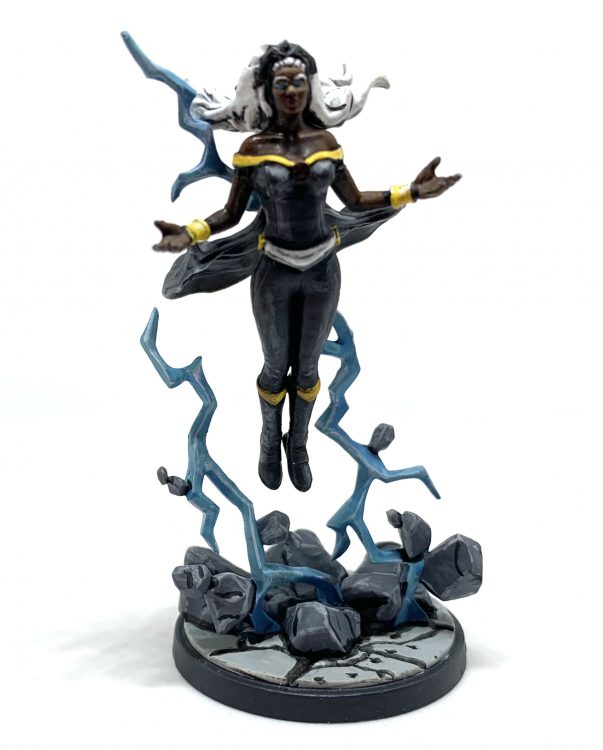
Team Tactics
Charming Thief allows Gambit to gain Power every time an enemy within Range 4 uses an Active or Reactive superpower this round. That’s a good range that your opponent may have trouble staying outside of, and a decent way to build up Gambit’s Power pool. Grade: B+
Children of the Atom lets an X-Men character remove any special conditions on them, and gives them a Power for each condition. It’s only one character though, not all the X-Men in the squad. Could be clutch in removing a Stagger or something at just the right time but probably not worth taking up space in your eight. Grade: C
If you’re a long-time X-Men fan you’re probably pretty excited to see Fastball Special. Colossus and Wolverine need to be within Range 2 of each other and then Wolverine becomes airborne! The target rolls 2 fewer dodge dice and gets Bleed. And Logan counts as Size 3, so that’s going to hurt! Grade: A-
First Class allows allied X-Men to pay no Power the first time they interact with an objective this round. This might save a couple Power here and there but it’s still not a barn burner. Best use is in the first round when you don’t have a lot of Power and want to grab an objective before your opponent. Grade: B
To Me My X-Men though is much better. The character playing it spends Power, and that number of X-Men may move Short toward the character. Yes, you need to have enough Power on the character that plays it, and the moves have to be toward a certain character, but there’s some flexibility in the 90 degree arc of “towards.” It’s no Avengers Assemble but giving multiple characters out of activation movement at a cost of 1 Power each is strong. The down side is that there’s no real shortage of self-move and movement-granting powers in the affiliation so this card doesn’t really feel necessary. Grade: B
Either Cyclops or Wolverine can play JEAN!!! when an allied Jean Grey is Dazed or KO’d and immediately perform an attack. This is pretty good since they both have very good builder attacks and even better spenders if they happen to have the Power handy. And this doesn’t cost anyone any Power or have any range restrictions, which is also sweet. Grade: A-

Jean herself can play Mental Domination in order to make an enemy advance and make a powerful surprise attack.If your opponent knows you have this card I can pretty much guarantee they’re going to keep any heavy hitters outside of Range 3 from Jean. While Jean herself doesn’t have any movement shenanigans to get closer and use this, keeping close to Storm or careful use of To Me My X-Men could make this a game decider. Grade: A-
Jonathan the Unstoppable is Honey Badger’s pet/sidekick. She can spend 2 Power to put a Jonathan token into play , and he can contest objectives. Jonathan will pop if an enemy ends within Range 1 of him, but that’s not terrible because if he’s not on the board during the cleanup phase you get to take the card back into your hand and use it again. Grade: B+
Journey Through Limbo allows Magik to teleport another character who is within Range 2 of her to within Range 3 of its current position. And because Limbo sucks that character now has the Incinerate special condition. The card doesn’t specify ally or enemy so you can use it on either one, if the ally is willing to eat an Incinerate (or maybe is immune). But if you’re using it on an ally the Orb of Agamotto is probably a better idea. This would be outstanding if it were reactive but you’re probably inconveniencing the enemy more than anything else. Grade: B+
Mind If I Cut In? lets Rogue tank an attack if she is within range and line of sight of the attacker. Rogue isn’t the beefiest defender but she can probably take a hit better than some others, so this is situational based on your roster. Grade: B
Pardon Me, Sugah is Rogue’s superpower duplication ability. It has different effects depending on whether Wolverine, Cyclops, Storm, Deadpool, or Magneto is nearby (and you can only choose one). It doesn’t have to be a friendly character, which is good because it also deals 1 damage to the target. Some of the abilities are better than others – for my money Storm’s adding two dice to the next attack or Wolverine’s Healing Factor are the best options. Grade: A-
Wolverine can use Weapon X Program to throw himself Short without taking damage, but it costs 3 Power to play it. It’s not great, as Wolverine can use The Best At What I Do to move himself Medium and make an attack, or to use his Berserker Barrage. I guess there might be other times when he needs the extra movement but he has better ways to use his Power. Grade: C
Wolverine also is eligible to bring X-Ceptional Healing. This card lets anyone with the Healing Factor power spend 3 Power to reduce damage from one attack to 1. Very useful if your opponent has someone with a disgustingly high Strength attack, or if your dice just simply turn against you. The 3 Power price tag is steep but if it means the difference between Logan staying Healthy or being Dazed it’s worth it. Grade: B
Lastly in our Wolvathon, Wolverines allows Logan and X-23 to team up and kick much butt. If they stay within Range 2 of each other they get to reroll any number of attack dice, which Logan really loves. They also deal a wound to anyone attacking them as long as it doesn’t Daze or KO them, and they can’t be pushed or thrown. A more stabby Til The End of the Line. It costs each character 3 Power to play this card but at the right time they can really ruin your opponent’s day. Grade: B+
Building Your Roster
The Uncanny X-Men
Sometimes AMG really captures the spirit of a character perfectly in the rules, like they did with Quicksilver. They’ve also done this with Cyclops in that he is reliable and boring. He has a solid builder attack with Range 4 and a strong Beam 5 Strength 7 spender attack, he can give allies a Short move (further lowering the value of To Me My X-Men and Weapon X Program above), and he can so an attack-move single action for himself. He has a kind of cool defensive power that lets him shoot attacks from outside Range 2 out of the air and possibly back at the attacker. Cyclops’ superpowers all cost Power though and he doesn’t have any great mechanism for generating it beyond his basic attack so he may not be able to use them all as often as you’d like. He probably fares better in an affiliation like Avengers or A-Force that help with the Power economy. But he can be a decent turret just standing around shooting stuff. Grade: B
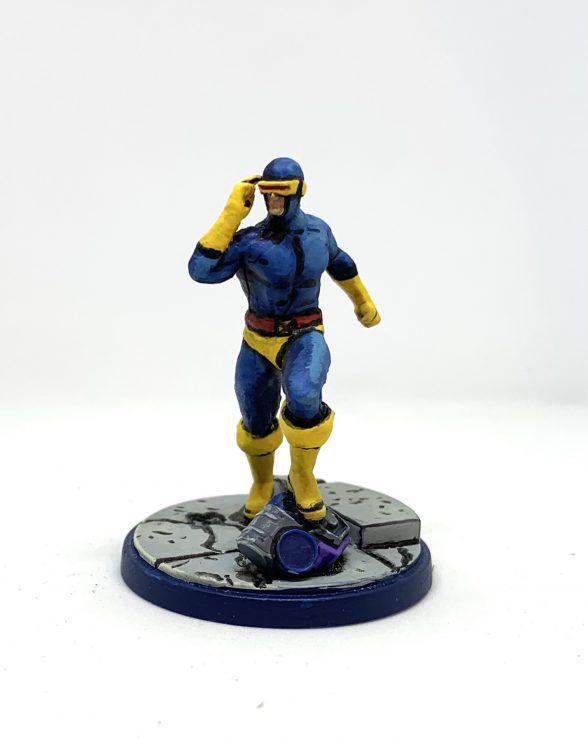
Storm brings a very good leadership to her squad but otherwise isn’t the most exciting character on the affiliation. Her attacks are fairly underpowered, although she can pay 3 Power to add two dice to them. She has a fairly weak throw that works on enemy characters and terrain, and she has Stealth. She’s also the only character with Flight in the X-Men currently. Storm’s builder attacks both give conditions (Shock and Stun). Nothing here really synergizes nicely with her leadership or with the rest of the affiliation, but for only 3 Threat she’s not terrible to just park on a close objective and shoot stuff while she slingshots allies toward the middle of the board. Grade: B
Beast has a ton of movement tools, both for himself and for enemies. If he gets a Wild on his builder attack he MUST place himself within Range 1 of the target. The attack starts at Range 3, so that’s a huge jump. His spender attack lets him move Medium for free, and push the enemy Short if he gets a Wild. Lastly he has a throw that has a shorter Range than Storms but also costs less. He can spend Power to reroll up to three defense or dodge dice, and with a 4 Physical defense that’s pretty solid. Beast himself only moves Medium but he’s on a 50mm base which would be gross if he had Long. Beast’s attacks aren’t anything to write home about but he’s going to be the one grabbing extract objectives and running away with them. Unless you’ve brought any number of other 3 Threat characters who do that job better, like Miles or Quicksilver. It must also be noted, since I didn’t do a character-by-character background above, that Henry McCoy is 100% the worst Henry in the Marvel Universe (behind Gyrich and even Pym) and possibly the worst person in the world. Take into consideration what it says about you as a person if you put him on the table. Grade: B-
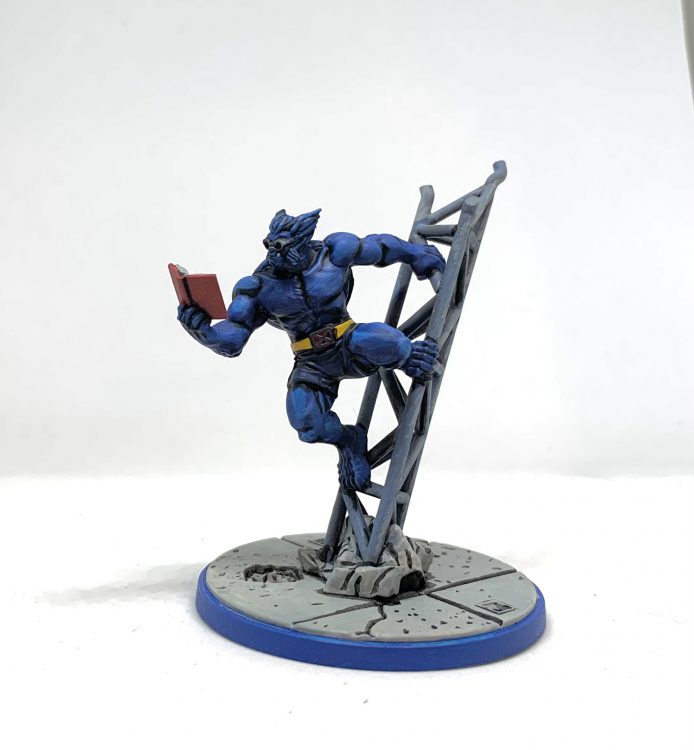
Cable is 5 Threat and thanks his lucky stars every day for Ebony Maw existing so that he’s not the worst 5 Threat character in the game. His leadership provides some compelling reason to take him in X-Force but there really isn’t a strong reason for him in X-Men when you could take M.O.D.O.K. or Scarlet Witch for the same Threat. He can provide a defensive buff to allies but his attacks aren’t that much better than Cyclops’. Grade: C
Colossus is a decent 4 Threat tank – he can bodyguard a nearby character and add 2 dice to his defense against Physical or Energy (which switches to counting blanks as successes when Injured, and doesn’t cost any Power), and he reduces damage by 1. Colossus may have some trouble having enough Power to do all that with only his Strength 5 builder so be careful not to get too ambitious with his tanking. Grade: B+
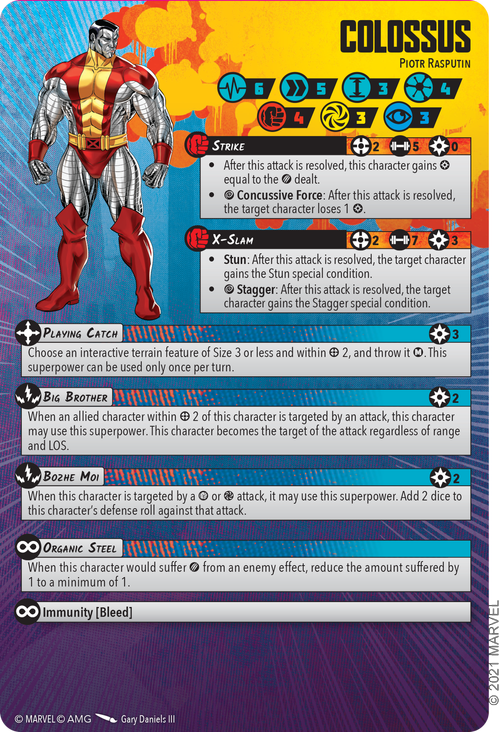
Domino is the first X-Man that I can get really excited about. She can spend Power to count Failures as Crits in her dice pool, and enemy characters never get to roll additional dice for Crits rolled against her. These two abilities will take her mediocre attack damage and defensive stats and crank them up. She may have some issues with Power generation as her builder attack only generates 1 per attack, but she should be able to hold a secure objective better than she seems to have any right to, as long as she’s not facing off against a heavy hitter. Grade: B+
I was not a child of the ‘90s so I’ve never understood the fascination of Gambit. That may color my review a little bit, I will admit. Gambit has two builder attacks, one of them only Strength 4, and a decent Beam 3 Strength 5 spender that counts Wilds as two successes. Not terrific damage output but he can spend 3 Power to add 2 dice to his next attack, making them pretty solid. And he can spend another Power to change a hit to a Wild, very useful since all his attacks have abilities triggered on Wild. But that’s about all he has going on. He has a defensive ability that does 1 damage to the attacker and lets him move Short, but that’s after the attack is resolved so Remy’s taking the hit one way or the other. It may act as a deterrent but it costs 2 Power so it means fewer powered-up 52 Card Pickup attacks, which are really the only notable thing on this card. Sorry buddy but you’re right, it Gambit. Grade: C+
Honey Badger is the only 2 Threat character currently available in Uncanny X-Men, and she’s one of the better ones in the game. She’s very durable for her threat and has perfectly fine attacks. Her Hamstring spender costs 3 Power, which is a bit high but it hands out Slow and Bleed if it does damage, and it has a chance to let her move Medium after the attack is resolved to keep her safe. And it’s not like you’re going to spend that Power on her bodyguard too often – she’s durable for a 2 Threat but she’s no Grampa Logan. Gabby’s biggest drawback is that she can’t contest, hold, or interact with objective tokens, but that’s what Jonathan is for. Keep Gabby moving and harassing enemies – if she’s within Range 1 they roll 1 fewer defense die against any of Honey Badger’s allies. Grade: B+
Jean Grey is going to do a lot of battlefield manipulation. I mean, that’s literally the name of her throw! And it’s a very good throw, up to Size 4 but only usable on terrain. Jean’s spender is a beefy Strength 9 that allows you to throw the target Short, and is explosive on a Wild. Both of these effects are before damage is dealt so you choose the order based on where she’ll do the most splash damage. It’s fairly costly at 6 Power, but Jean is generating an extra one every round, plus her Mystic builder grants full power equal to damage and has Sap Power. She can also push Activated characters, friend or foe, as often as she has Power for (once per character). What Jean lacks though is any real defensive tech – her 3/4/5 defenses aren’t terrible and hopefully she can out of range of any significant Physical bruisers. She’s a good utility piece but at 5 Threat I would have liked to see either a defensive or movement superpower on her card. Grade: B
Magik is a fairly tough beatstick with some solid Mystic attacks. She has average Physical and Energy defense and a higher Mystic. Illyana has some additional defense against Mystic on top of that from her Sorcerer Supreme of Limbo. Her Mystic builder is Strength 5 with pierce, nice, and she has an Energy builder as well that’s weaker but guarantees 1 Power. Magik’s spender is only Strength 6 but adds the fails from her roll and the defender’s to the total, which is bonkers and I love it. Lastly she has her signature stepping disks allowing Magik to spend 1-3 Power to teleport the same Range. For 3 Threat she deals solid damage with the possibility of some nice spikes and has great mobility.Additional movement tricks are always welcome in X-Men, as are Mystic attacks. Grade: A-
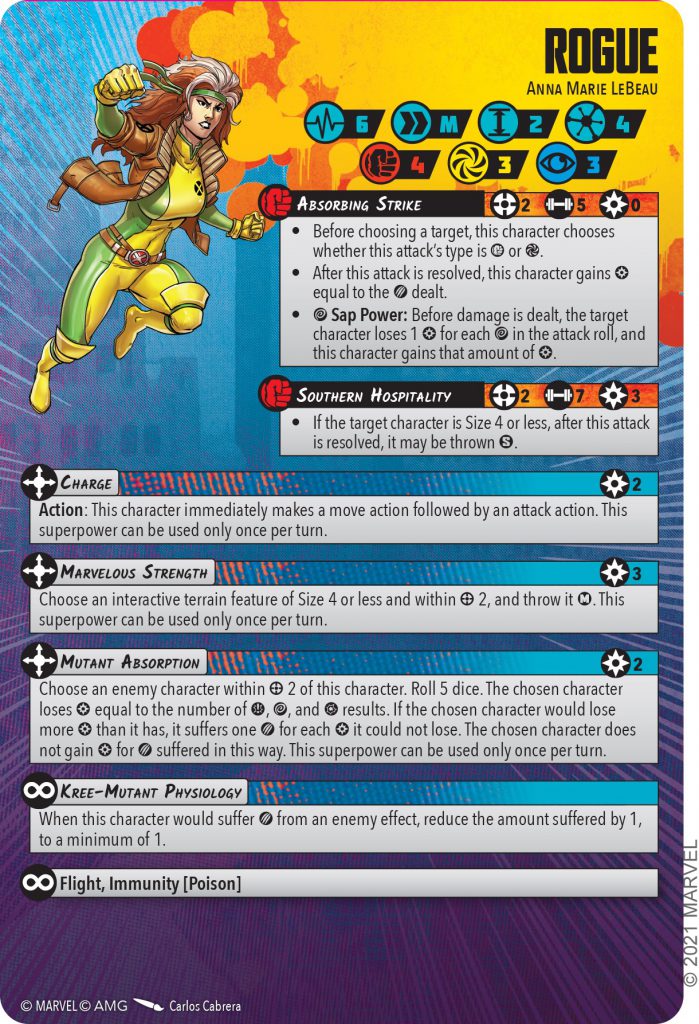
Rogue is really going to ruin someone’s day, and you will laugh and laugh. Between her Absorbing Strike builder which has Sap Power and her Mutant Absorption power you can really drain an enemy’s Power supply down before they get a chance to do something cool with it. Rogue has to get up within Range 2 to use both of these, but fortunately her Kree-Mutant Physiology reduces damage and she has a little better than average Physical defense. To spend all the Power she Saps, Rogue has an okay spender, a good throw, and a Charge to help her get up close. Rogue is more of a utility/threat piece than a damage dealer, but that’s okay because there’s no shortage of damage on the X-Men. Grade: B+
Wolverine has been covered in the Defenders and X-Force columns, but in short (no pun intended. See, Wolverine is really short. In fact I’m kind of upset he’s not Size 1) he’s a monster of a blender who is tougher than he looks thanks to his Healing Factor. Just be mindful that he can’t interact with or hold objectives while on his Injured side, although he can still contest and help secure (but he’s Injured so unless everybody else on that objective is also Injured he’s not going to count). At that point you’re probably better off just hunting down and murdering your opponent’s models anyway, and he’s the best there is at doing that, bub – even if it isn’t very pretty (well, he’s pretty good at it, anyways). Grade: A-
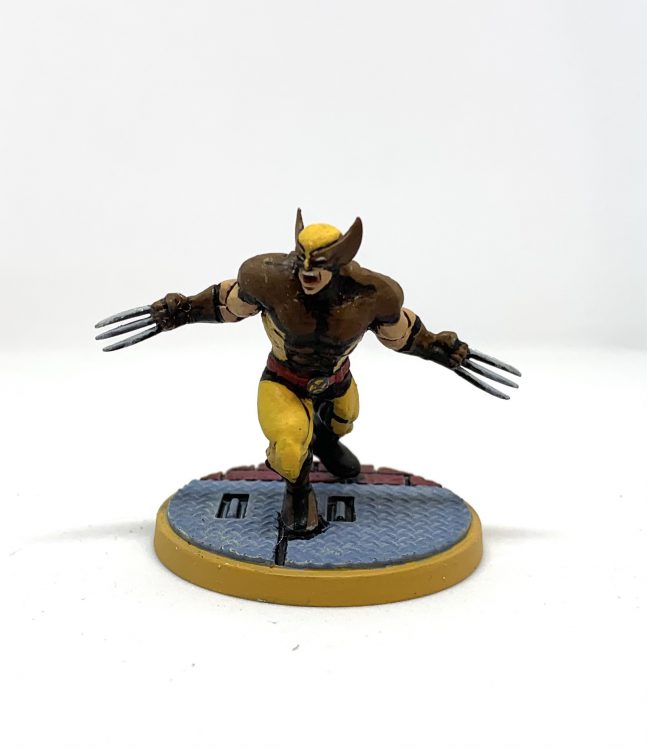
X-23 is another solid damage dealer, and only 3 Threat. She’s more mobile than she might appear at first, as she has a bunch of different ways to advance in addition to her regular Medium movement. Her builder is fairly standard but gives both Bleed and Pierce on a Wild, and her spender is only 2 Threat, also with Pierce. Laura can also innately reroll 1 die in her attack and defense pools, with no cost and no once per turn limit. Give her the killing (or Dazing/KO’ing) blow and X-23 can advance short and use her builder again. Defensively X-23 isn’t great – 3/3/2 and 10 Stamina is pretty average although that Mystic defense is unfortunate – but her Healing Factor will help out a lot there. Note that you can’t use Fastball Special with her because this version is not a Wolverine, which is totally unfair. But she’s a very good 3 Threat beatstick. Grade: A-
And Friends
Who to bring along really depends on what you want to do with your X-Men, because frankly they’re not the best at really anything. So if you’re really intent on playing X-Men then yeah, you’re going to want some help from out of the affiliation.
The usual suspects all show up here – Enchantress, Miles, Quicksilver, Toad for extract grabbing. Domino loves some rerolls and dice fixing, so Shuri is a good bet.
To get your affiliation ability you’re probably looking at Storm, Domino/X-23, Wolverine as your core. Maybe Cyclops instead of Logan if mayonnaise is too spicy for you. That’s 10 Threat so you have room to pick up some heavy hitters to fill out your squad. Maybe Scarlet Witch or Doctor Strange to provide support, and then Okoye, Toad or Wong to round things out to 17. Or you can start with Storm/Domino/Beast at 9 and add in any two of Quicksilver, Miles, Black Cat for 15 and really own the scenario game, with Storm sitting back flinging these already very fast characters everywhere.
So Are They Any Good?
The newer additions to the X-Men lineup really expand the in-affiliation options and bring them into their own. You have a deep bench of some very strong characters, plus Gambit. I’d put down good money the X-Men will be the first affiliation with three leaders when Professor X drops. I mean he’s got to, right?
Have any questions or feedback? Drop us a note in the comments below or email us at contact@goonhammer.com.


